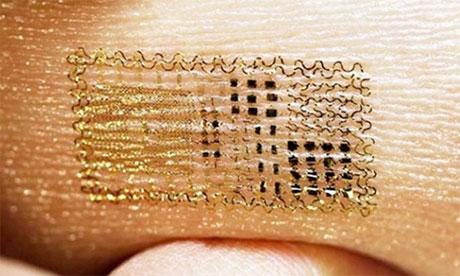
Repeat trips to the doctor could become a thing of the past thanks to a new technology that can monitor your health and wellbeing remotely – directly from the surface of your skin. Researchers at the University of Illinois have developed an electronic tattoo that can be printed straight on to the body to track patients' symptoms – measuring heart rate and temperature, strain and hydration – and then beam the information back to your doctor. It might sound like something from Brave New World, but this could be the first step in a future of networked healthcare.
The project, pioneered by materials scientist John Rogers, is the latest development in ongoing work into flexible "epidermal electronics". His team have previously engineered stick-on stretchable electronic circuits with an elastic polymer backing, which could simply be applied to the skin like a temporary tattoo – but with the downside that they could easily wash off.
"They were fine for an office environment," Rogers told the MIT Technology Review, "but if you wanted to go swimming or take a shower they weren't able to hold up."
The researchers have now developed a technique to print circuits directly on to human flesh with a rubber stamp, which can then be covered with a spray-on bandage to form a protective coating. The ultrathin mesh electronics operate like a standard computer circuit board – with electrodes, sensors and wireless communication systems – but are made up of a matrix of stretchy, serpentine wires that flex with the movement of the body. By removing the elastic backing, the device is now one thirtieth as thick as before, and can adapt more easily to the rough surface of the skin.
Rogers sees one of the major applications being the ability to monitor wound healing, with an electronic tattoo applied close to the surgical wound before the patient leaves hospital, allowing doctors to track the healing process remotely. As Wired magazine reports, the devices could also see patients sent home from surgery with a monitoring system that does the job of several heavy-duty machines, such as electromyographs and electrocardiograms, that are usually confined to hospitals.
Those fearing a Big Brother future of barcoded proles will be relieved to hear that the tattoos can only be worn for around two weeks, before the skin's natural exfoliation process causes them to flake off.

